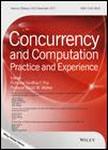版权所有:内蒙古大学图书馆 技术提供:维普资讯• 智图
内蒙古自治区呼和浩特市赛罕区大学西街235号 邮编: 010021

作者机构:Vilnius Gediminas Tech Univ Dept Syst Graph Vilnius Lithuania Vilnius Gediminas Tech Univ Lab Parallel Comp Vilnius Lithuania
出 版 物:《CONCURRENCY AND COMPUTATION-PRACTICE & EXPERIENCE》 (并行学和计算:实践与经验)
年 卷 期:2024年第36卷第10期
页 面:e7877-e7877页
核心收录:
学科分类:08[工学] 0835[工学-软件工程] 0812[工学-计算机科学与技术(可授工学、理学学位)]
主 题:cost and performance trade-off heterogeneous cloud resources parallel communication-intensive software Pareto front performance prediction resource selection
摘 要:Cloud providers offer flexible infrastructures and on-demand services, including the capability to deploy low cost virtual resources of many different types. However, the diversity of cloud resources followed by the important trade-off between cost and performance makes the resource selection a challenging task for users in the case of parallel communication-intensive software. The paper presents cost- and performance-aware resource selection for parallel discrete element method (DEM) software as a service (SaaS) on heterogeneous OpenStack cloud. The developed resource selection uses preliminary application-specific benchmarks of size smaller than targeted problems and the performance prediction based on speedup of parallel computations to obtain Pareto optimal solutions and to select the best configuration of containers from user s perspective. Hybrid parallelization of DEM software is developed by using OpenCL for shared-memory multi-core architectures and MPI for internode communications on distributed-memory computer clusters. Round up and proportional pricing schemes are examined and compared from a user s perspective. Lower cost of computations obtained by using the proportional pricing scheme is always preferable for users. However, the difference approaches 1.0% of the cost calculated by using proportional pricing scheme, when long lasting computations are performed. The prediction tends to underestimate the execution time of DEM SaaS, but its accuracy is sufficient to obtain the same Pareto optimal solutions by using measured and predicted execution times. Pareto front and linear scalarization propose to select configurations of containers capable of exploiting higher memory bandwidth, which is specific to memory bandwidth bound DEM computations.